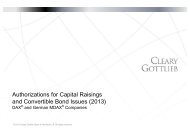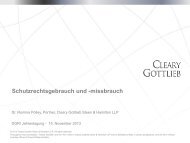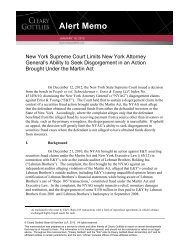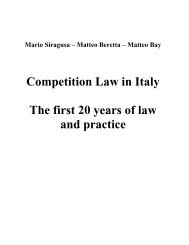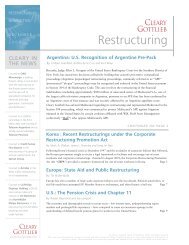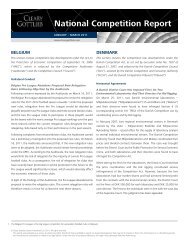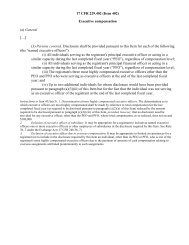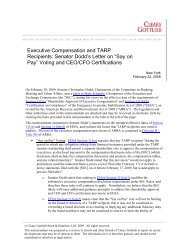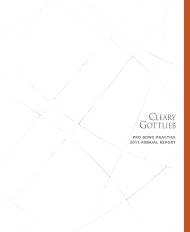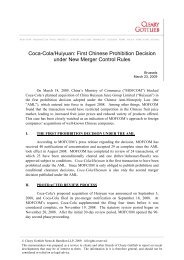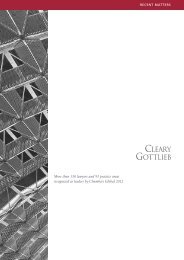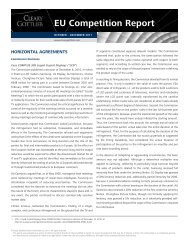Securities Activities of Banks in the GLB Era - Cleary Gottlieb Steen ...
Securities Activities of Banks in the GLB Era - Cleary Gottlieb Steen ...
Securities Activities of Banks in the GLB Era - Cleary Gottlieb Steen ...
Create successful ePaper yourself
Turn your PDF publications into a flip-book with our unique Google optimized e-Paper software.
standard <strong>of</strong> bank “coercion” required for a violation <strong>of</strong> <strong>the</strong><br />
Anti-ty<strong>in</strong>g Statute (<strong>the</strong> “Proposed Coercion Interpretation”).<br />
(i) The rationale for <strong>the</strong> Proposed Large Customer Safe-<br />
Harbor Exemption is based on <strong>the</strong> notion that large and<br />
sophisticated customers are unlikely to be forced or<br />
coerced by a bank to take unwanted products or<br />
services. Based on that premise, <strong>the</strong> 2004 Bank<br />
Submission contends that ty<strong>in</strong>g/reciprocal deal<strong>in</strong>g<br />
arrangements between a bank and such<br />
large/sophisticated customers should not raise any <strong>of</strong><br />
<strong>the</strong> anti-competitive concerns that <strong>the</strong> Anti-ty<strong>in</strong>g<br />
Statute was <strong>in</strong>tended to prevent.<br />
It is not expected, however, that <strong>the</strong> Board will act<br />
favorably on <strong>the</strong> proposed Exemption <strong>in</strong> <strong>the</strong> near<br />
future (it at all).<br />
(ii) The Proposed Coercion Interpretation articulates a<br />
“coercion analysis” to be applied as guidel<strong>in</strong>es for<br />
identify<strong>in</strong>g customers that cannot be coerced by banks<br />
<strong>in</strong>to accept<strong>in</strong>g unwanted products/services.<br />
(A) The 2004 Bank Submission recommends that<br />
<strong>the</strong> Board clarify that <strong>the</strong> “coercion analysis”<br />
(set out <strong>in</strong> <strong>the</strong> Proposed Coercion<br />
Interpretation) and <strong>the</strong> “mean<strong>in</strong>gful option”<br />
analysis (set out <strong>in</strong> <strong>the</strong> Proposed Anti-ty<strong>in</strong>g<br />
Interpretation and described <strong>in</strong> Part I.C.1.b<br />
below) for mixed-product arrangements be<br />
applied as two separate tests under <strong>the</strong> Antity<strong>in</strong>g<br />
Statute (i.e., <strong>in</strong> <strong>the</strong> context <strong>of</strong><br />
circumstances where <strong>the</strong> Proposed Large<br />
Customer Safe-Harbor Exemption, or any o<strong>the</strong>r<br />
exemption from <strong>the</strong> Statute, is not available).<br />
(B) Certa<strong>in</strong> key pr<strong>in</strong>ciples <strong>of</strong> <strong>the</strong> “coercion<br />
analysis” articulated <strong>in</strong> <strong>the</strong> Proposed Coercion<br />
Interpretation <strong>in</strong>clude <strong>the</strong> follow<strong>in</strong>g:<br />
9



